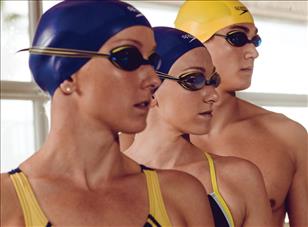How to Choose a Swim Cap
 Swim caps make you more hydrodynamic in the water and are a great way to keep long hair out of your face while you swim. Choosing a certain type of swim cap is fairly straightforward and is influenced by what type of swimming you do, but there are a few considerations you should keep in mind before purchasing this vital piece of swim gear. Whether you’re training for the Olympics, building endurance for a triathlon, or simply want a cool, comfortable cap to match your swimsuit, we’ll help you choose the best swim cap for your use case.
Swim caps make you more hydrodynamic in the water and are a great way to keep long hair out of your face while you swim. Choosing a certain type of swim cap is fairly straightforward and is influenced by what type of swimming you do, but there are a few considerations you should keep in mind before purchasing this vital piece of swim gear. Whether you’re training for the Olympics, building endurance for a triathlon, or simply want a cool, comfortable cap to match your swimsuit, we’ll help you choose the best swim cap for your use case.
Lap Swimming vs. Water Exercise
Lap swimming means head-down, face-in-the-water swimming, while water exercise can be anything from general swim workouts to water therapy and aqua aerobics. Water exercisers usually use caps to keep their hair dry and away from the face. Athletes doing water aerobics, aqua jogging, or other forms of gentle water exercise may want to wear a LYCRA™ swim cap. Lycra swim caps are made from a soft, breathable mesh material that helps keep hair out of their eyes without the tight, heat-retaining fit of traditional swim caps. Lap swimmers more commonly use caps to help them move through the water more efficiently and will prefer the hydrodynamic qualities of latex or silicone swim caps.
Practice vs. Racing vs. Open Water
Swim practice caps are made of latex or silicone. They're simple, inexpensive and quite similar from brand-to-brand, and are also commonly used during meets and competition. Modern racing caps are made of molded silicone, which provides a smoother surface and reduces drag during races. They are a bit more expensive than traditional swim caps.
Open water racers or swimmers may want to opt for a silicone or even a neoprene swim cap which provide a bit more insulation from cold water to help keep your head warm. They also provide superior floatation to latex caps (although latex caps are equally acceptable and widely used on open water swims). Open water swimmers should also consider buying a cap in a bright color to make it easier for officials and rescuers to spot them in the water.
Lots of Hair vs. No Hair
If you have medium to long hair, then a silicone cap will suit you best. Silicone caps outlast their latex counterpart and are more tear resistant. They also provide a tight fit without tugging at your hair. Typically softer to the touch, silicone as a swim cap material is gentler on the hair and is less irritating when taking a cap on and off. Those with longer hair and braids will need a snug fit to keep their cap from falling off. Silicone caps can provide a contoured fit for your personal head size while keeping everything in place.
If you have little or no hair, a latex cap will provide a better fit. Made of latex rubber, the latex cap tends to stretch more easily so they can be worn by virtually anyone. Regular-sized caps fit most swimmers with average head sizes. If an average-sized swim cap feels loose, try a junior or kids cap for a snugger fit. The cap should be tight enough to remain on your head throughout a race or workout, but not so tight that it leaves a line or begins to hurt your head. If you're worried your cap may not stay on, try a swim cap with a chin strap that comfortably holds your cap into place while you're swimming.
Pick What You Like Best
When it comes down to it, there are no strict rules about swimming headwear. Pick a cap that meets your needs, whether it comes down to comfort, insulation, or just the color. And since swim caps are quite inexpensive, it's a good idea to buy a few so you can store some extras in your swim bag. That way you're sure to have one on hand in case one rips.
Also consider buying a fun cap! Many companies manufacture holiday-themed caps, caps with funny sayings, and caps in a variety of colors to match your swimwear. You can also purchase customized caps that feature names, nicknames, and logos for yourself or a team. A unique swim cap can make hopping in the water a lot more enjoyable, whether for practice or competition.
